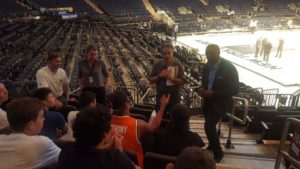We have written several times on storytelling and its continued value in all forms; knowing who you are, what you do and being able to communicate that fact simply and succinctly in a world of white noise is more valuable today than ever before. Lots of screaming going on, but when you listen, what are you hearing?
That’s why the power of multimedia in storytelling continues to grow. We know all about podcasting and its appeal. In urban areas you can’t go more than a few feet where someone is not listening to something on an audio device. Music, talk, whatever; we are tuned in and hopefully not too tuned out. Listening has become more of an oasis than ever before, if we can do enough of it.
Last week we had National Radio Day, and early in October will be College Radio Day, which is a very worthwhile effort to acknowledge audio storytelling in all shapes and forms. I have seen and continue to embrace, the great students and professionals who are enhancing the art of storytelling across colleges and high schools. It is an invaluable trait in business today and hope it will continue to be nurtured and grow. 
We are also working on a platform which we will be telling you more about in the coming weeks called Future Sports Business Leaders; created for young people with an interest in sports and media, their own community which a few will help mentor.
With students returning to campuses in droves in the past few weeks, many of whom looking to find ways to effectively storytell, the value of creating one’s own voice; individually, collectively, has never been easier or more important. In sports, that ability to story tell, not just in audio, but in video and on social media, us invaluable, and is being recognized more and more by Universities as a way to get messaging out and those secondary stories told to a wide, and also a niche but very fervent audience.
The voice creation ability takes work, but the tools to do so can take place on campuses big and small, and even down to the high school level with the right support and entrepreneurial effort. We have seen how students from schools Like St. Bonaventure, Syracuse and Ithaca have worked their way into Radio Row at The Super Bowl, and how schools like Hofstra and Fordham have found a voice in the crowded New York media landscape. There are probably hundreds of others also doing some good work, and collecting that network and sharing storytelling is an opportunity still to be explored.
Even the “Best of” on the collegiate level falls still into a bit of a vacuum. Sports Video Group does amazing year-end awards for work in college video, and CoSIDA has its annual awards as well. A recent piece in Sports Business Journal by Michael Smith talked about how the launch of the ACC Network and the growth of low cost streaming opportunities on college campuses will help create more opportunities for young people in story creation, but more can be done and recognized to both encourage and champion opportunities and work being done.
None of this by the way, really has to do with audience size. Zach Weiner, the founder of Overtime Sports, told a story last summer about how he created a sports radio show at the University of Pennsylvania, and through his diligence, attracted some great guests who were intrigued by his ability and his chutzpah. The cache of Penn helped, but his determination to learn was even more important. How many listeners did he have? He said at some point maybe as few as a few dozen, but that didn’t matter. He proved concept, established himself, took advantage of the opportunity Penn gave him and off he went. The same can be done almost anywhere there is effort and interest. Also listen to our podcast with Buster Scher, about how he launched his career because of a high school radio opportunity. Given the chance, storytelling arises.
So as students head to school looking to grow opportunity, spoken voice, as well as video and print, is as great an opportunity to build brand and story tell now more than ever. It needs to be cultivated and encouraged and maintained with a like-minded community, but it can be done almost anywhere, so long as the presenter is professional in manner and inclusive in storytelling.
How many schools have taken this route to story tell beyond their borders? It’s a question we have been asking for years, and will some day try and corral. For right now, we will be listening and sharing, and hopefully many others will do the same!
